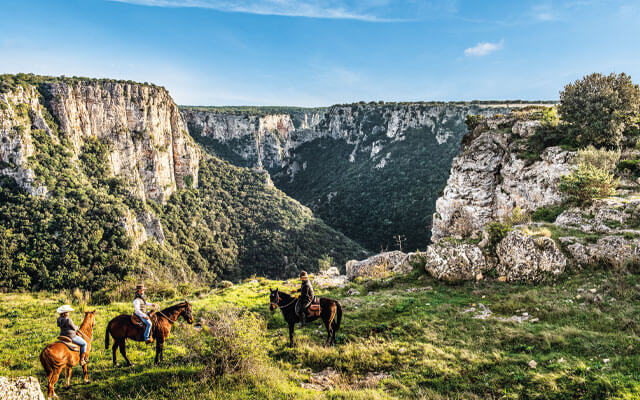
Kick off in the ancient city of Taranto. The city’s origins are mired in mystery – legend has it that it was founded by Taras, a son of Poseidon, but historians claim it was established by Spartans during a wave of Greek colonisation in the 8th century BCE. To discover more about its ancient heyday, make for the MArTA Archaeological Museum, home to the city’s superb collection of antiquities. Also worth searching out is the Cathedral of San Cataldo in the slightly dilapidated old town, and the Aragonese castle overlooking Ponte Girevole, a swing bridge that spans the waterway between the Mar Piccolo (Small Sea) and Mar Grande (literally, the Large Sea). On rare occasions, the bridge is opened to let ships sail out of the naval base in the Mar Piccolo.


If you’re after a gift or memento of your time in Puglia, head to Grottaglie, 23 km east of Taranto. The town has been famous for its ceramics since medieval times and still today artisans sell their hand-crafted wares in the hilltop Quartiere delle Ceramiche (Pottery District). Look out for tableware adorned with blue flowers and the town’s signature rooster. To round the day off push on to Campomarino where you’ll find some beautiful beaches backed by aromatic sand dunes.
Some 20 km northwest of Taranto, Massafra is known for its chiese rupestri (rock churches). Many of these are decorated with Byzantine frescoes and can be visited on guided tours. Visits generally take in the Gravina di San Marco, the ravine around which the town is set, and several churches including the Crypt of Santa Marina and the Sanctuary of the Madonna della Scala. This 18th-century sanctuary, built over an earlier medieval church, features a fresco of the Virgin Mary with Child, a reference to a miraculous event that supposedly happened here when two deers knelt before a painting of the Madonna. Yet more rupestrian sights await in Mottola, 13 km to the northwest. Dubbed the balcony of southern Puglia, the hilltop town commands sweeping views of the Gulf of Taranto and beyond to Calabria. These can best be admired from the panoramic balcony known locally as ‘La Rotonda’ at the top of the historic centre. Just outside town, the Petruscio ravine is a spectacular sight, pitted with cave dwellings that were inhabited from the Neolithic period to the Middle Ages. Rupestrian churches lie hidden in the surrounding farmland, including the Church of San Nicola, considered the Sistine Chapel of the rupestrian civilisation thanks to its hypnotic frescoes, all painted between the 11th and 14th centuries.


Birthplace of the silent cinema star Rudolph Valentino, Castellaneta sprawls around the Gravina Grande, a majestic gorge that plunges to a depth of 145 m at its deepest point. There are several dazzling viewing spots from the historic centre whose tightly packed houses huddle together on the edge of the vertiginous cliffs. In the small town of Laterza, the Gravina di Laterza is the largest and most spectacular of the canyons that cut through the Gulf of Taranto. The lushly vegetated ravine, which stretches for 12 km and reaches depths of more than 200 m, is an important wildlife habitat supporting many species of birds. Various paths traverse it, providing exhilarating hiking and mountain biking. In the town itself, try to visit the Cantina Spagnola, a haunting 17th-century crypt adorned with unusual frescoes and sculptural decorations.
En route to the tablelands of the Alta Murgia, stop off at Gioia del Colle to visit its wonderfully preserved Norman-Swabian castle. Originally built in the Byzantine age, it was revamped by Frederick II in 1230 and today hosts the town’s small National Archaeology Museum. Before hitting the road again, make sure to pick up some of the creamy mozzarella for which the town is rightly renowned. The largest town in the Alta Murgia, Altamura boasts a charming medieval centre, crisscrossed by narrow lanes and hidden claustri (small courtyards). In the heart of the action, pedestrian-only Corso Federico II leads to the Cathedral of Santa Maria Assunta, the town’s show-stopping cathedral. A 13th-century hybrid of Romanesque and Gothic architecture, it’s the only cathedral built in Puglia by the Swabian emperor Frederick II. Nearby, the Forno Antico Santa Chiara is a top spot to stock up on Altamura’s celebrated bread. Dating to 1423, it’s the oldest bakery in town.

Near the regional border with Basilicata, Gravina teeters on the edge of a precipitous ravine spanned by a towering Roman-era bridge. Among its highlights is its landmark cathedral and the Crypt of San Michele delle Grotte, Gravina’s most important rock church and the town’s original 8th- to 9th-century cathedral. Visits to the area and the town’s fascinating underworld of cellars, cisterns and tunnels can be arranged through Gravina Sotterranea (www.gravinasotterranea.it).

As you head northwards, stop off at Minervino Murge to admire fine views over the Alta Murgia National Park and visit the locally revered cave church, the Grotta di San Michele Arcangelo. Then continue on to Andria, the final port of call on this trip. The city, Puglia’s fourth largest, harbours some fine old buildings, including the Cathedral of Santa Maria Assunta whose origins date to the 11th century. But as much as the architecture, it’s the city’s cheese that excites visitors. In particular, Andria is renowned for producing Puglia’s best burrata.

BuyPuglia is the digital system tailored to suit your tourism business in Puglia. Our matching platform is an easy tool to explore meeting opportunities with Puglian suppliers and learn about their tourism &.. cultural products. BuyPuglia ranks buyers and sellers based on entered information. Shared interests are paired, helping plan effective meetings and delivering optimized supply &.. demand solutions.